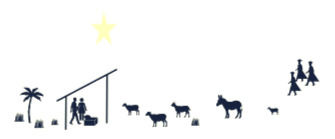Celebrating Las Posadas
- pmcgeary5
- Dec 2, 2021
- 3 min read

December—frequently a season of holiday cheer and frenzied preparation, but at its heart this month’s focus, at least among the Christian community, is about a precious child, a vulnerable family and their struggle to find a safe place to stay in the face of a hostile government.
SJRAISE in collaboration with the EDSJ Latino Ministries Program will be hosting three Las Posadas celebrations: in Bakersfield (Dec. 16), Fresno (Dec. 20), and Lodi (Dec. 22). This playful event seeks to dramatize in story, music, and ritual the journey of the Holy Family to find safe shelter. We hope many of you will join us for these festive occasions.
As we remember the struggles of the Holy Family to find some place to stay, we’ll also be recalling the many immigrants on our border who find themselves in similar straits - lonely, destitute, vulnerable to so many dangers. We’ll make a vivid connection to their struggles by assembling our Uncaged Art traveling exhibit at each venue. The exhibit features images created by immigrant children detained at La Tornillo Detention Center outside El Paso, Texas. SJRAISE received permission to reproduce these images as part of an education effort about the struggles of immigrants. You can see a brief video about the Uncaged Art exhibit here.
To deepen our understanding of the extraordinary struggles of immigrants at our borders and the factors that drive them to make such a long and treacherous journey, SJRAISE in conjunction with the Creation Care and Anti-Racism Commissions sponsored a webinar on Nov. 20th with UK photojournalist, Sean Hawkey, who spent over six weeks traveling with groups of migrants from Honduras to the U.S. border. SJRAISE made a modest contribution to his expenses during the journey.
Sean began by showing a brief video, Going North: Why Central Americans Migrate. It highlights some of the major reasons people are leaving their homes to head north, despite the many dangers that await them: hunger, kidnapping, rape, robbery, death. Sean calls these the “motors of migration.” Many who set out never reach the border - they die along the way.
One major driver of migration, Sean noted, is political corruption and resulting violence. Honduras, as just one example, is essentially run by a drug lord. Gang attacks, extortion, rape, murder are routine. The Washington Office on Latin America (WOLA) puts it bluntly, “The deeply rooted dynamics of violence and corruption in the countries of the Northern Triangle of Central America continue to represent one of the greatest challenges to ensuring the implementation of effective policies focused on human rights, the rule of law, and citizen security, and enabling an adequate and comprehensive approach to the structural causes that continue to generate unprecedented levels of migration of persons fleeing Guatemala, Honduras, and El Salvador.”
Sean recounted heartbreaking stories he heard from migrants along the way who were forced to watch the rape and/or murder of loved ones. Everyone he met along the way had such a stories. When the choice is the death of your family member or fleeing, you flee. Anyone would, we ourselves included.
The other major “motor of migration” Sean mentioned was the impact of climate change. Climate change has shifted the weather patterns of the region leading to extensive droughts in some areas (one region hasn’t been able to harvest a crop in ten years!) and in other areas, increasingly severe storms that have drowned crops, flooded communities, and eroded infrastructure. All colluding to undermine the capacities of rural communities to survive. Growing poverty, hunger, and migration are the consequences. For more on this connection, read here.
Racism also plays a role as a “motor” as indigenous and communities of African descent are harassed and their land confiscated in Honduras and Guatemala.
During the Las Posadas we recall that the Holy Family found many doors shut in their faces - no room in the inn. What does our faith call us to do in the face of the suffering immigrants we see? Sean suggested we consider these steps—a kind of Advent practice:






Comments